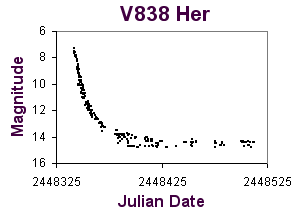V838 Her (Nova Herculis 1991)
The visual discovery of V838 Her by George Alcock of Yaxley, Peterborough, England, on 1991 March 25, 4.35 UT, is a somewhat unlikely story. Having been clouded out, Alcock decided to observe what he could with his 10x50 binoculars from the comfort of inside his home. Every half hour Alcock dilligently looked out through the glass of his window to see what he could (or could not) see with his binoculars. Finally, in the wee hours of the morning, just before the dawn of the morning Sun, the clouds broke and a clear sky emerged. While scouting the heavens, Alcock noticed an unfamiliar 5th magnitude star in the constellation of Hercules. What Alcock had stumbled upon through a plate glass window was the bright nova now known as V838 Her! In addition to Alcock's visual finding, an independent photographic discovery was made by M. Sugano on March 24.78 UT at a magnitude of 5.4 on Tri-X film (Alert Notices 138, 139, 140, 141).
 |
| Light curve of V838 Her from the AAVSO International Database; March 9, 1991, to September 25, 1991. |
An investigation of the Palomar Sky Survey plates showed that a precursor to the event was identified at magnitude 20.6 on the blue plate, while on the red plate it was visible at 18.25. The outburst of larger than 13 magnitudes makes V838 Her one of the largest amplitude novae of recent times (Leibowitz et al. 1992).
As bright as V838 Her was, only about 700 observations have been archived in the AAVSO International Database in the ten years since its discovery. The archived data reveal that V838 Her is a fast nova, as seen by its rapid decline. The last positive observations the AAVSO have for this nova date back to the mid-1990s, when it was seen around magnitude 14.5. Since then records indicate that the nova has faded to fainter than 14th magnitude.

